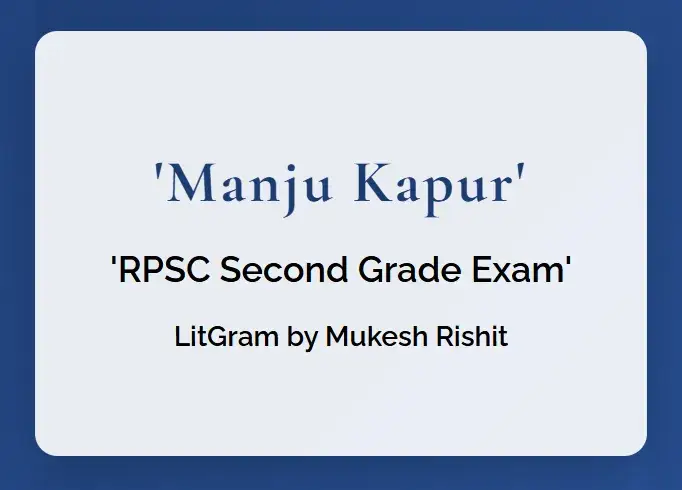Introduction to Manju Kapur: Are you preparing for the RPSC Second Grade English exam and feeling overwhelmed by the vast syllabus? Don’t worry! This comprehensive guide focuses on one of the most significant authors in contemporary Indian English literature: Manju Kapur. We’ll explore her literary contributions, analyze key themes, and provide you with essential tips for acing your exam. Let’s dive into the world of Manju Kapur and boost your RPSC exam preparation!
Manju Kapur Biography: Understanding the Author’s Journey
Manju Kapur, born in Amritsar, Punjab, has emerged as a prominent voice in Indian English literature. Her journey as an author began with the publication of her debut novel, “Difficult Daughters,” in 1998. Kapur’s background as an English professor at Miranda House, University of Delhi, has significantly influenced her writing style and themes.
Kapur’s works often draw from her experiences and observations of Indian society, particularly focusing on the lives of middle-class women. Her novels explore the complexities of family relationships, the struggle for individual identity, and the clash between tradition and modernity in contemporary India.
Exploring Manju Kapur Books: Key Works for RPSC Exam
To excel in the RPSC Second Grade Exam, it’s crucial to familiarize yourself with Manju Kapur’s major works. Here are some of her most significant novels that you should focus on:
| Novel | Year Published | Key Themes |
|---|---|---|
| Difficult Daughters | 1998 | Focuses on a woman’s struggle for independence and identity during India’s partition. |
| A Married Woman | 2002 | Explores themes of love, desire, and societal expectations in the life of a married woman. |
| Home | 2006 | Examines relationships and gender roles within a traditional Indian family setup. |
| The Immigrant | 2008 | Deals with topics of migration, cultural assimilation, and the challenges of adjusting to a new life in a different country. |
| Custody | 2011 | Highlights issues of marriage, divorce, and the emotional impact of custody battles on families. |
Each of these Manju Kapur books offers unique insights into Indian society and the human condition. Let’s take a closer look at one of her most celebrated works.
Manju Kapur Difficult Daughters: A Critical Analysis for RPSC Preparation
“Difficult Daughters” is often considered Manju Kapur’s magnum opus. Set against the backdrop of India’s partition, the novel tells the story of Virmati, a young woman who defies societal norms to pursue education and a relationship with a married professor.
Key aspects to focus on for your RPSC exam:
- Historical Context: The novel’s setting during the partition provides a rich historical backdrop. Understanding how this context influences the characters and plot is crucial.
- Feminist Themes: Virmati’s struggle for autonomy and education reflects broader feminist issues. Analyze how Kapur portrays women’s rights and societal expectations.
- Generational Conflict: The novel explores the tensions between different generations of women. Pay attention to how these conflicts drive the narrative.
- Narrative Structure: Kapur employs a non-linear narrative structure. Consider how this technique enhances the storytelling and character development.
Analyzing Manju Kapur Novels: Themes and Literary Techniques
When studying Manju Kapur novels for the RPSC 2nd Grade exam, focus on recurring themes and literary techniques. Here are some key areas to consider:
- Women’s Autonomy: Kapur consistently addresses the struggle for women’s independence in a patriarchal society. Analyze how her characters navigate societal expectations and personal desires.
- Domestic Spaces: Many of Kapur’s novels explore the dynamics within Indian households. Pay attention to how she uses domestic settings to reveal broader social issues.
- Education as Empowerment: Education often serves as a tool for empowerment in Kapur’s works. Examine how characters use education to challenge societal norms.
- Cultural Conflicts: Kapur frequently portrays the tension between traditional values and modern aspirations. Consider how these conflicts drive character development and plot.
- Symbolism: Look for recurring symbols in Kapur’s novels. For example, the concept of “home” often represents both comfort and confinement.
Understanding these themes and techniques will help you analyze Manju Kapur’s works more effectively in the RPSC exam context.
Preparing Manju Kapur for 2nd Grade: RPSC Exam Strategies
To excel in the RPSC Second Grade Exam sections related to Manju Kapur, consider the following strategies:
- Close Reading: Don’t just skim through the novels. Engage in close reading, taking notes on key passages, characters, and themes.
- Character Analysis: Create detailed character profiles for major characters in Kapur’s novels. Understand their motivations, conflicts, and development throughout the story.
- Thematic Mapping: Identify and map out recurring themes across Kapur’s works. This will help you draw connections and provide more insightful answers in the exam.
- Historical Context: Research the historical and social context of each novel. Understanding the backdrop will enhance your interpretation of the text.
- Literary Criticism: Read scholarly articles and literary criticism about Kapur’s works. This will provide you with different perspectives and analytical approaches.
- Practice Questions: Regularly attempt practice questions related to Kapur’s works. This will help you become familiar with the types of questions asked in the RPSC exam.
Potential Exam Questions and Analysis
To help you prepare effectively, here are some potential exam questions related to Manju Kapur’s works:
Manju Kapur Quiz
Quiz Results
Remember, when answering these questions, always support your arguments with specific examples from the texts. This demonstrates your thorough understanding of Kapur’s works.
Recognizing Excellence: Manju Kapur Awards and Literary Achievements
Understanding Manju Kapur’s literary achievements can provide valuable context for your RPSC exam preparation. Here are some notable awards and recognitions:
- Commonwealth Writers’ Prize for Best First Book (Eurasia Section) – “Difficult Daughters” (1999)
- Sahitya Akademi Award – Shortlisted for “Home” (2008)
- DSC Prize for South Asian Literature – Longlisted for “The Immigrant” (2011)
These Manju Kapur awards highlight her significant contributions to Indian English literature. In the RPSC exam, you might be asked to discuss how these recognitions reflect the themes and quality of her work.
Conclusion: Mastering Manju Kapur for RPSC Success
Studying Manju Kapur’s works is not just about memorizing plots and characters. It’s about understanding the nuanced portrayal of Indian society, the complexities of human relationships, and the ongoing struggle for individual identity. By thoroughly analyzing her novels, you’ll not only be well-prepared for the RPSC Second Grade Exam but also gain valuable insights into contemporary Indian literature.
Remember, Manju Kapur’s literary works offer a profound insight into the complexities of Indian society. Her novels consistently address themes of women’s autonomy and societal expectations, which are likely to be examined in the RPSC test. When preparing Manju Kapur for 2nd Grade RPSC exam, focus on her major works and recurring themes.
Good luck with your exam preparation! With dedicated study and a deep understanding of Manju Kapur’s contributions to Indian English literature, you’re well on your way to success in the RPSC Second Grade Exam.



1 Comment
Can I just say what a relief to find someone who actually knows what theyre talking about on the internet. You definitely know how to bring an issue to light and make it important. More people need to read this and understand this side of the story. I cant believe youre not more popular because you definitely have the gift.